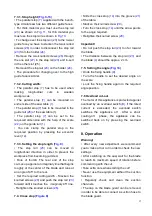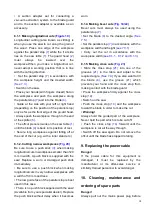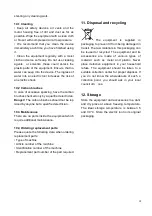
9
Danger!
When using the equipment, a few safety
precautions must be observed to avoid injuries
and damage. Please read the complete
operating instructions and safety regulations
with due care. Keep this manual in a safe place,
so that the information is available at all times. If
you give the equipment to any other person,
hand over these operating instructions and
safety regulations as well. We cannot accept
any liability for damage or accidents which arise
due to a failure to follow these instructions and
the safety instructions.
1.
Safety regulations
The corresponding safety information can be
found in the enclosed booklet.
Danger!
Read all safety regulations and instructions.
Any errors made in following the safety
regula-tions and instructions may result in an
electric shock, fi re and/or serious injury.
Keep all safety regulations and instructions
in a safe place for future use.
SAFE WORK
1. Keep the work area orderly
–
Disorder in the work area can lead to
accidents.
2. Take environmental influences into
account
–
Do not expose electric tools to rain.
–
Do not use electric tools in a damp or wet
envi-ronment.
–
Make sure that the work area is
well-illuminated.
–
Do not use electric tools where there is a
risk of fire or explosion.
3. Protect yourself from electric shock
–
Avoid physical contact with earthed parts
(e.g. pipes, radiators, electric ranges, cooling
units).
4. Keep children away
–
Do not allow other persons to touch the
equipment or cable, keep them away from
your work area.
5. Securely store unused electric tools
–
Unused electric tools should be stored in a
dry, elevated or closed location out of the
reach of children.
6. Do not overload your electric tool
–
They work better and more safely in the
specified output range.
7. Use the correct electric tool
–
Do not use low-output electric tools for
heavy work.
–
Do not use the electric tool for purposes for
which it is not intended. For example, do not
use hand-held circular saws for the cutting of
branches or logs.
–
Do not use the electric tool to cut firewood.
8. Wear suitable clothing
–
Do not wear wide clothing or jewellery,
which can become entangled in moving parts.
–
When working outdoors, anti-slip footwear
is recommended.
–
Tie long hair back in a hair net.
9. Use protective equipment
–
Wear protective goggles.
–
Wear a mask when carrying out
dust-creating work.
10. Connect the dust extraction device if
you will be processing wood, materials
similar to wood, or plastics.
–
If connections for dust extraction and a
collect-ing device are present, make sure that
they are connected and used properly.
–
When processing wood, materials similar to
wood, and plastics. operation in enclosed
spaces is only permitted with the use of a
suit-able extraction system.
11. Secure the workpiece
–
Use the clamping devices or a vice to hold
the workpiece in place. In this manner, it is
held more securely than with your hand.
–
An additional support is necessary for long
work-pieces (table, trestle, etc.) in order to
prevent the machine from tipping over.
–
Always press the workpiece firmly against






































